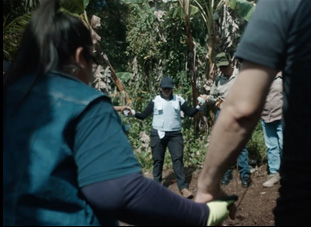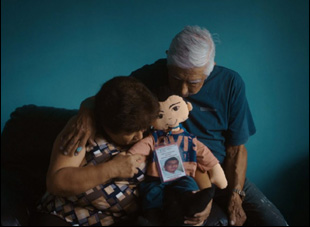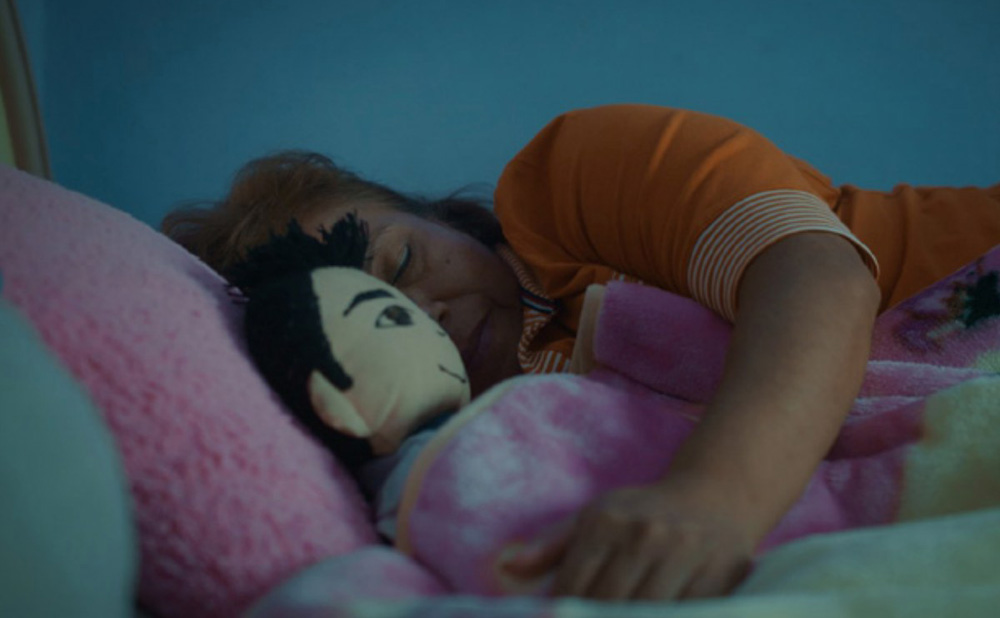You might wonder who is around the answer the prayers of those assembled in the mist-covered mountains of Mexico where a group of parents whose children have disappeared have come together to raise their arms to the sky and intend to dig deep into the earth in “Hasta Encontrarlos (Till We Find Them)” to find any clue as to their whereabouts. If it seems no one is watching from above, there can be at least some comfort in the sense that someone is bearing witness as filmmaker Jean Chapiro observes machetes being sharpened to cut through the weeds and boots are laced up to climb a hill that seems as if it goes on for eternity. They may be in search of the missing, but even beyond reciting the names of their loved ones before looking for them, among the hundreds of thousands that have vanished as part of the country’s notorious organized crime kidnapping schemes annually, they make their presence known in the heartrending short where there is always space for them in the frame.
Chapiro, who recently won a Student Academy Award for the short, had noticed upon learning of the search parties that the families had a unique way of keeping their children as much a physical part of their lives as they had been emotionally, creating healing dolls that could fill the empty seat at their dining room table. In visits with Araceli Salcedo Jimenez, who pines after her daughter Rubi, and Norma Veronica Alvadaro and her partner Romuldo Aguirre Hernandez, whose son Edgar went missing, the children can be seen in spirit and “Hasta Encontrarlos” observes the new family that has formed as a result of these tragedies as a support group develops between those who are at a loss for answers but feel less lonely in their investigation amongst one another. “Hasta Encontrarlos” is bound to only make that circle even bigger as it chronicles an excavation, but illustrates how vividly those missing continue to live on the surface for the families that have to carry on in their wake and recently, Chapiro spoke about the great sensitivity required to tell such this particular story, confronting the grim reality of the situation and taking on the burden of sharing it with audiences after it’s largely been left up to the relatives of the missing for so long.

The missing people crisis in Mexico is something that I grew up knowing about. Everyone knows about it, but no one really dares to talk about it because it’s very dangerous and it could get you or your family in trouble. The government always tells you that if people go missing, it’s because they were involved in stuff that they shouldn’t have [been], or because they’re bad people, [which] goes hand in hand with being involved with things you shouldn’t be.
I went to this event for Women’s Day in New York City on March of 2022 to support the organization that’s run by mostly Latin American women that live in New York City, and I met Araceli there. She flew all the way from Veracruz in the south of Mexico where she’s from, just to tell her story to a crowd of people that hadn’t heard it before. And after I heard her speak, I was so moved by how honestly she spoke and how vulnerable she was that I went up to her and I told her, “I’m going to do everything in my power to help you to get your message across.”
Beyond Araceli, was the process going on the search and then interviewing the loved ones of the missing or was that a process that took time?
I met the families before I went on the search. There wasn’t anyone else in New York with Araceli that day, but then she told me about the collective that she had founded in our first Zoom interview after we met and later, she introduced me to the families, so even many more families that appear in the film and I had Zoom calls with them weekly for about six months before I even started shooting. What ended up in the film doesn’t take place in that long of a period of time, but we did have footage from that event in March of 2022, and then I kept filming in August and in November and December [of last year], so it takes place over different periods of time, but I could only include just a few hours of footage that we had.
I imagine the learning curve was steep in relating to the families about these deeply distressing matters. Was it difficult to facilitate these kinds of conversations?
It was tremendously hard and it never got easy. I knew everyone’s story because I had met all of them over Zoom before we started shooting, but hearing their story is one thing and another is standing in their home where their children used to live with them and just feeling their absence and all the emotions around what not having them with them means for the families. I wouldn’t say there was actually a learning curve because I always struggled and also it was a super small crew — me, the DP, and the sound person, and at times the DP, [who’s] from Veracruz, had to step out because the story was even more close to home for him than anyone else, so I had to stay and take control of the camera.
You’re really able to capture the feeling of absence in those homes. How conscious were you of the compositions in filming the interviews or cutting together those sequences inside the homes?
That was a conscious decision. I knew this could translate to a visual story mostly because of the healing dolls, that’s what they call them, and when I saw them in person, they were bigger than I had imagined, so I visually tried to to show that [missing] boy in space and use the camera to communicate to audiences what that boy feels like for them and how the dolls will help them cope with that in any way possible.

Yes, definitely. One of the days when we went up with them to look for the clandestine graves, they had actually found remains of a person. That drastically changed not only my understanding of things but also how I wanted to structure the film. At first, we weren’t even sure what we were getting ourselves into because when we got there [to the forest], there was a lot of security and we were going in two [groups] and we were escorted by two or three police trucks from the National Guard, so they went up with us to dig and to look. They don’t actively [do that themselves], but they’re taking care of the families that do and as outsiders, we weren’t allowed to actively dig ourselves and we weren’t actually able to film a lot of the stuff that was going on because it’s not fair for the person or for their family, so there was a whole ethics discussion involved on not only what we end up showing, but what we filmed and where we pointed our camera. We were very, very careful and we followed Araceli’s lead on that.
What’s it been like getting this out into the world?
It’s been getting more attention than I could have ever imagined or dreamed of. We premiered at Guadalajara Film Fest in L.A., and we’re waiting to hear from other festivals. It hasn’t played in Mexico yet, and I’m eager to play it with all of the collective in the audience. That’s really exciting for me and the Student Academy Awards has given it a huge platform that I’m very grateful for, and not only that, but it’s given the topic validation on a world stage, so I hopefully this can reach as many people as possible because people go missing not only in Mexico every day, but around the world and it’s a topic that we should all know about and talk about more.




